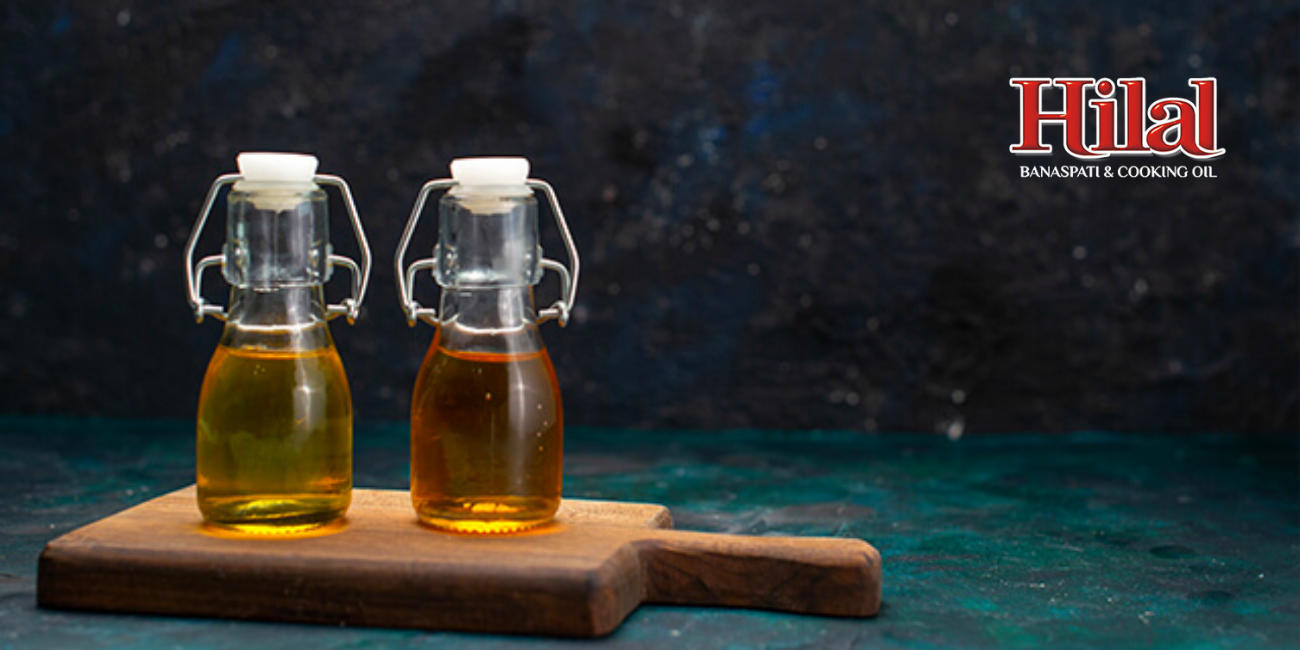
The Healthiest Cooking Oils: Types, Uses & Benefits
Cooking oils are a kitchen staple in all households, irrespective of which country or type of cuisine. Each place has one type of best cooking oil which would be commonly available from the source of plant found in that region. While Mediterranean cuisine has olive oils, Caribbean cuisine uses coconut oil or peanut oil.
Contrary to popular belief, you don't need to eliminate your regular cooking oils to cut down fats or lose weight. Even though oils are technically fat, the type of oil chosen for cooking matters as much as the quantity. Choosing the best cooking oil depends on what and how you intend to cook with it.
To know the best cooking oil for health, one needs to consider the cooking process, namely frying, baking, stir fry, grilling, or tempering, and for each of these methods, analyzing the composition of each of the cooking oils in terms of its smoking point and treating it right. It's essential to know the smoking point as this can release toxic compounds to your dishes in addition to tasting bitter and stripping off essential nutrients from ingredients cooked.
Let's have a look at the different parameters that distinguish among cooking oils in Pakistan: 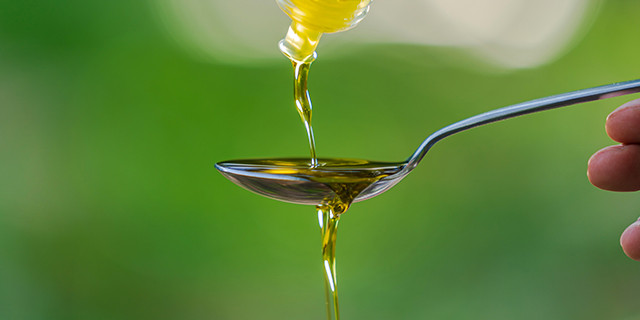
Refined cooking oils have longer shelf-life, and a high smoke point.
1. STABILITY OF COOKING OILS
The stability of the oil is its ability to resist reacting with oxygen and breaking down to form free radicals. Three main factors influence the oxidative stability of cooking oils – the ratio of fats, antioxidant levels, and extent of refinement.
a) The ratio of fats: Edible oils are predominantly fat, which have different molecular bonds based on their inherent source being plant-based (like coconut oil) or animal-based oil (like butter
Let's have a little background on the types of fat.
Saturated Fatty Acids (SFAs)
Saturated fatty acids don't have any double bond, and their carbon chain is filled or 'saturated' with hydrogen atoms, making them solidify at room temperature, specifically tropical oils – such as coconut oil and palm oil and animal fats – such as lard or butter. Though saturated fats are flavourful, it should be consumed in small quantities, ideally less than 10% of the permissible daily calories, the reason being they can raise blood cholesterol levels and increased the risk for heart disease.
Unsaturated Fats
Unsaturated fats too can be of plant or animal origin. However, they are healthier to be used more regularly cooking since it reduces bad cholesterol, inflammation, and blood pressure while providing essential nutrients for cell generation and building your body. Unsaturated fats can be further classified to Monounsaturated and Polyunsaturated fatty acids.
Monounsaturated Fatty Acids (MUFAs)
Monounsaturated fatty acids miss two hydrogen atoms, have 'mono' or one double bond between their two carbons and are also stable and resistant at high temperatures, namely avocado, nuts, olive and peanut oil.
Polyunsaturated Fatty Acids (PUFAs)
The polyunsaturated fatty acid has two or more double bonds and misses multiple hydrogen atoms, making them oxidation prone. PUFAs like seafood oil gives omega-3 and omega-6 and is also rich in Vitamin E. Plant-based options are soybean oil, corn oil, and sunflower oil.
b) Extent of refinement
Unrefined - Unrefined cooking oils are extracted mechanically by exposing minimal heat, which keeps their natural nutrients intact. They are available in three types-virgin oil, extra virgin oil, and pure oil. The category depends on the percentage of oleic acid present in it and the method of extraction used.
For instance, Extra Virgin Olive Oil (EVOO) contains only 1%oleic acid and comes from first pressing with no added chemicals and heat.Virgin olive oil, like EVOO, comes from the first pressing itself though it has a slightly higher oleic acid content of 3%.
Pure or regular olive oil is a combination of second pressed oil and treated oil. It's still termed as 'pure' since there are no additives init. It definitely of lower quality than EVOO and virgin olive oil with an oleic acid content of 3-4%.
Refined - Refined cooking oils are made by highly intensive mechanical and chemical processes. Modern extraction consists of several steps. Manufacturers' the primary reason to refine oils is to produce neutral flavour, longer shelf-life, and a high smoke point. Some oils are inedible, and refinement is necessary as it lowers the stability of oil because this process strips away natural antioxidants and exposes the oil to heat.
c) Antioxidant level
As the word suggests, antioxidants protect against oxidation which is a process that happens faster when oil is exposed to high heat for an extended period. Some of the best cooking oils can have natural antioxidants like linseed oil while others have synthetic antioxidants added to it.
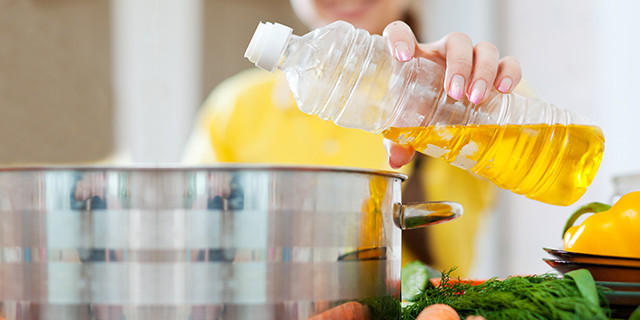
The best cooking oils are the ones with very low smoke points and these should be used as a dressing for salads.
2. SMOKE POINT OF COOKING OILS
The smoking point of fatty acids is the temperature at which oil or fat begins to smoke and breakdown, subsequently losing essential nutrients and generating harmful toxic elements. Many kitchens accidents can be prevented if the right oils are chosen for a given technique of cooking.
The best cooking oils are the ones with very low smoke points and these should be used as a dressing for salads. When these oils are heated beyond their smoke point, oil could catch fire instantly. Certain oils like virgin and extra virgin olive oils are unrefined. Refining also affects the stability as the more refined an oil, the lesser the impurities and free fatty acids that make oil smoke.
5 THINGS TO KEEP IN MIND WHILE CHOOSING
THE BEST COOKING OILS FOR HEALTHY HEART AND MIND

Reading the label helps you know the properties of the oil better, and match the cooking oil with the right method of cooking.
According to the USDA Dietary Guidelines, oils are a vital source of essential fatty acids and vitamin E and necessary to be part of a balanced diet. Dietary fats help with nutrient absorption, develop the nervous system and provide the needed energy for our bodies.
We need to analyse what cooking oil is made of. This apart, we need to use various oils throughout the week and not just one type. The right selection of cooking oil for Pakistani cooking especially is important because cooking methods are different from that of the west. With a plethora of oil brand options in the market, it is vital to make an informed decision.
Nutrition Facts Label – Read the label whether the oil is refined or not. Many manufacturers also add information as apart of business ethics like its composition, which includes saturated fat, trans fat content, the ratio of Omega 6 to Omega 3, and the amount of and polyunsaturated (PUFA) monounsaturated (MUFA) fatty acids.
To help you identify and choose better cooking oil, here is the list of criteria that one needs to look for in any edible oil label before purchase:
1. High Omega-3
Omega-3 helps to lower triglyceride levels and improve cholesterol profiles and have cardio protective effects. It is found in foods that include plants like walnuts and soybean, fatty fish, flaxseeds, and salmon.
2. Ratio of Omega-6 to Omega-3
Though one is confused with the other, omega-6 is pro-inflammatory. Omega-3's which are found in fish oil, walnuts, fatty fish, and flaxseed are anti-inflammatory and reduce the risk of stroke and heart disease.
Omega-6 is found in foods, including vegetable oils such as soybean and corn oil. Studies conducted by the Pakistani Council of Medical Research suggests choosing a 5:1 ratio of Omega-6 to Omega-3 is ideal. This means that no more than 5% to 10% of your total caloric intake should come from omega-6.
Omega-6 is needed only in trace amounts in our diet, which we would be getting directly from most foods. But when the level of omega-6 increases, it causes inflammation. Getting that right ratio is the key.Disproportionate levels of omega-6's to omega-3's increases the risk of these diseases and treating most of these symptoms is actually by reducing the effect of omega 6. Look out for the ratio 5:1 in your cooking oil label while on your next grocery trip!
3. Unsaturated Fats
The best cooking oils are those with unsaturated fats (i.e.,polyunsaturated and monounsaturated) namely most vegetable oils and olive oil, which lowers your risk of heart disease while ensuring food nutrients remain intact instead of saturated and trans fats. They are easier to digest as well compared to saturated animal fat like butter and lard.
4. Method of Cooking
Choose the right oil for each different technique of cooking.Oils with high smoke points, i.e. those which take a longer time to breakdown, are ideal for high-heat cooking such as deep-frying and stir-frying like peanut oil, sesame, or soybean oil.
Those with a moderately high smoke point are ideal for sauteing over medium heat like corn, canola, and olive oil. Oils with very low smoke points like flaxseed, pumpkin seed, and walnut oils are suitable for salad dressing. Some are versatile for both salads and frying like olive oil, grapeseed oil, and avocado oil.
5. Trans fat
Trans fat is a process where liquid fats are processed to increase their shelf life by hardened it by a process called hydrogenation. It can be naturally-occurring which means there could be trans fat in a particular animal's gut and when we consume those animals, traces of it can come to our system; it could also be artificially produced, which are most harmful. https://www.health.harvard.edu/staying-healthy/the-truth-about-fats-bad-and-good
Check the nutrition facts label if trans fat is mentioned as-is under total fats, or it is said as partially hydrogenated oil or shortening. It’s mostly used in the commercial baking of cookies, doughnuts, pies, and crackers to increase shelf life and make them crispy. Trans fat increases the bad cholesterol levels in your body and decrease the healthy cholesterol level. Research has linked trans fat to heart disease, stroke, diabetes and other chronic conditions because it creates inflammation in the body.
WHAT ARE THE WORST COOKING OILS?
Anything labeled as "hydrogenated" or "partially hydrogenated" or even as trans fat 0g in the list of ingredients, should be avoided. As in the USA, still, if 0.5 gms of trans fat is added, they can round it to 0 gms, though technically you would be consuming 0.5 gms in one serving of food item, which can quickly add up, if not careful. These are often found in margarine and bakery products.
Certain Refined oils: It is ideal to have a balance and reduce the quantity of refined oil in your diet and opt for Kachi Ghani, cold-pressed or virgin unrefined oils.
WHAT ARE THE BEST COOKING OILS?
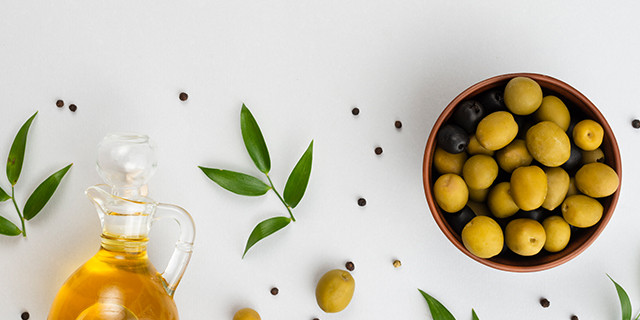
Olive oil contains monounsaturated fats in high quantities, which helps improve HDL cholesterol.
1. Olive oil
· Rich in phytochemicals and some Extra Virgin Olive Oils (EVOO)also contain oleocanthal, a natural anti-inflammatory compound, which puts it in the category of healthy oils.
· It contains monounsaturated fats in higher quantities than other oils thereby improving HDL cholesterol with just 4 tbsps. of virgin olive oil a day.
· Can be used for drizzling over salads, Italian dishes, very low heat cooking. However, it is not considered the best cooking oil for Pakistani cooking, since it has a very low smoke point. Moreover, the beneficial polyphenols may degrade while cooking.
2. Sesame oil
· Helps in bone growth and reduces blood pressure. It is one of the best cooking oils to be used for massage, especially in winters.
· Along with Vitamin E, sesame oil has several antioxidants like phytosterols, lignans, and sesamol which fight free radicals in our bodies and reduce the risk of chronic diseases. Sesame oil has a balanced ratio of Omega 6to Omega 3, which helps in heart health and immunity.
· This edible oil derived from sesame seeds is used for culinary purposes and has medicinal properties. Traditional Taiwanese and Chinese medicine use sesame oil to treat joint pain, cuts, toothaches, scrapes, and menstrual cramps.
· Sesame oil is high in polyunsaturated fat, but it should not be heated for long. Suited for medium-high flame cooking.
· Oil pulling is a traditional practice for enhancing dental health. Sesame oil is ideal for removing harmful bacteria and promoting oral hygiene.
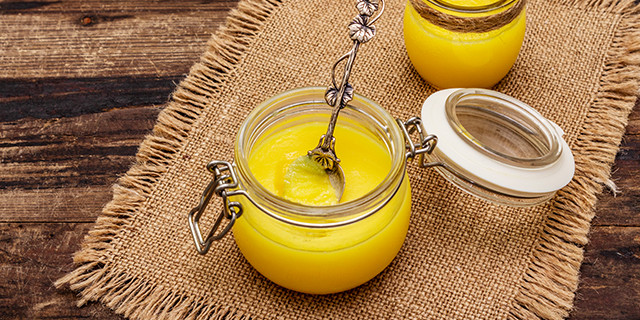
Rich in nutrients, Ghee is ideal for Pakistan cooking – frying, tempering, and making desserts as it has a higher smoke point than most cooking oils.
3. Ghee
· Ghee is a treasure house of nutrients and is an essential part of Pakistani cuisine. It can be quite surprising for many that ghee consists of fat-soluble vitamins which aid weight loss.
· It's rich in Omega 3 fatty acids, Vitamin A, E, K, and butyric acid, which helps digestion and brain development.
· Suitable for Pakistani cooking – frying, tempering, and making desserts, as it has a smoke point of 250 °C which much higher than most cooking oils.
· Though ghee has several health benefits, it comes under the saturated fat category and is calorie-dense. Be mindful of consuming only within the permissible limit per day.
4. Mustard Oil
· It is the preferred cooking oil for Pakistani cooking. Mustard oil is popularly used for cooking in the northern parts of Pakistan. Loaded with health benefits, it promotes blood circulation and contains MUFA, PUFA, and alpha-linolenic acid. Adding mustard oil to your diet can be beneficial in maintaining a healthy heart.
· Its anti-infective properties can help treat digestive tract infections.
· Glucosinolate in mustard oil helps to reduce cancer risks.
· It has a high smoking point, so it's perfect for deep
· frying.
· Mustard oil has an anti-fungal component that protects food from fungal growth, and hence, it is ideal for making pickles and treating dandruff issues from the scalp.
· Mustard oil contains vitamin E, improving skin health.
· Mustard oil is a natural stimulant, and boost metabolism improves circulation and relieves sinus congestion.

5. Groundnut Oil
· Groundnut or Peanut oil has a high smoke point and is the best cooking oil for Pakistani cooking.
· Groundnut oil is rich in Vitamin E is applied directly to the skin to treat dry skin, eczema, arthritis, and joint pain.
· Peanut oil is rich in vitamin E, MUFAs, and PUFAs, folates, and protein and are low in saturated fats. All in all, it is considered suitable for all-purpose cooking.
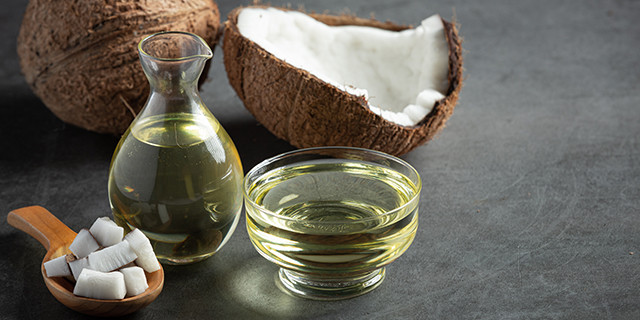
From fighting skin aging to maintaining healthy hair, Coconut oil has many health benefits.
6. Coconut Oil
· Virgin coconut oil has been used to maintain healthy hair and body massage for centuries. It’s made by pressing the fat from the fresh coconut 'meat' or the white part, which endows coconut oil with many health benefits.
· In the southern parts of Pakistan, it is considered as the best cooking oil for cooking south Pakistani dishes. Refined coconut oil is made from extracting oil from the dried coconut meat, also called copra.
· Coconut oil has linoleic acid and up to 50% lauric acid, which can be hydrating, antimicrobial, and fights signs of skin aging.
· Coconut oil has a component called Medium Chain Triglycerides or MCTs. A study suggests that MCTs help promote satiety and prevent fat storage.
· On the flip side, too much coconut oil usage or going for a commercial quality instead of virgin oil can have adverse effects and not more than 13 gms a day is advisable, being predominantly saturated fat.
· Coconut oil is good for oil pulling. Oil pulling means literally swishing harmful bacteria from your mouth. It helps prevent dental inflammation and balance the hormones.
How to do Oil cycling?
Rotate different types of cooking oils so that your body gets all kinds of nutrients. Rotating cooking oils can increase the efficiency of two or more different oils to balance fatty acids and antioxidants. A combination of saturated and unsaturated fats in the diet is advisable to get the best of both worlds — however, it's ideal to be mindful of each's quantities.
Final Word
When it comes to daily intake, 20-25g of visible fat from oils is fine. As far as Pakistani cuisine and preference for cooking oil are concerned, ideally, 10g can be from coconut oil or ghee and 10-15g from mustard or peanut or sesame oil is good. In a nutshell, as long as it is well distributed throughout the day, it is healthy.
